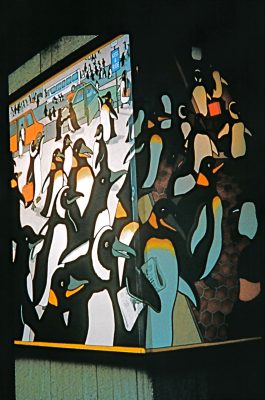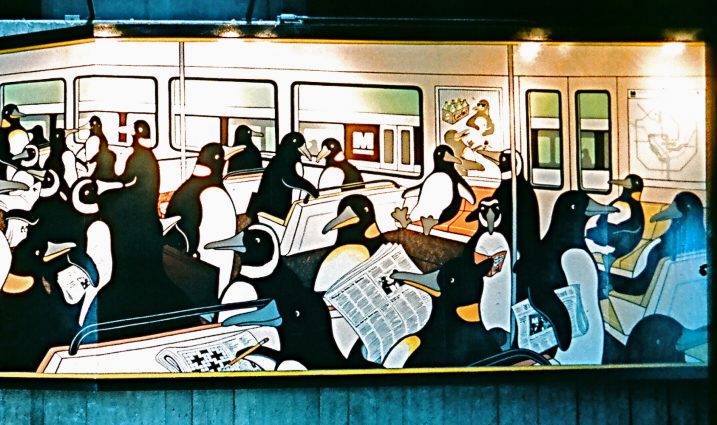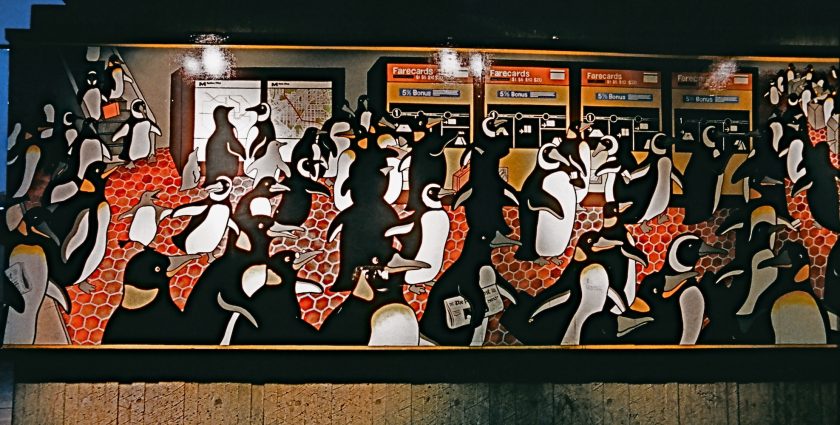A flock of commuters lost in transit for more than a decade will once again grace the walls of Silver Spring’s Paul S. Sarbanes Transit Center with the return of the Penguin Rush Hour mural. Depicting dozens of the black-and-white birds streaming through the Metro station and boarding Metro cars—briefcases and fare cards in hand—the artwork is slated to be re-installed within a month or so after an 11-year absence.
And this time around, the upgrading of the 100-foot-long mural from plywood to aluminum panels guarantees the flightless birds will stay put.

“The mural is returning in a more durable, permanent configuration, most likely in late March. Stay tuned, as there’s a desire to have some sort of event to celebrate its return,” said Don Scheuerman of the Montgomery County Department of General Services.
Sally Callmer Thompson, the artist who created the mural in 1990 for the newly opened Silver Spring Metro station, said she’ll travel from her Virginia Eastern Shore home to reconnect with her friends at the event—those with wings and otherwise. “I just found out last month about the aluminum panels and cannot wait to see them,” Thompson, 62, said.
Because the artwork was meant to be temporary when first installed by the Washington Metro Area Transit Authority (WMATA) along Colesville Road and on a station wall, Thompson used exterior house paint to paint the 25 four- by eight-foot plywood panels.
“It became an unofficial mascot of Silver Spring—an exceptional reaction,” said Laurent Odde, WMATA’s Art in Transit Program Manager. He added that Metro artworks are intended to capture a sense of the community and life around a station. Currently, about one in three of the 91 Metro stations feature artwork.
“Art not only makes a station more beautiful, it makes it feel safer. It shows that the station is not just a place to grab a bus or train,” he said.

Over the years, the penguins appeared on coffee mugs and T-shirts in Silver Spring shops, and even on the signage used as the Metro Station evolved into a Transit Center decades later.
“I think the design gained popularity because it’s easy to imagine penguins as people during the rush hour at a Metro station, the way they walk upright and flock together,” Thompson said. “My personal favorites are the penguins shown reading The Washington Post and doing the crossword in the train car.”
But time and the elements were not kind to the beloved penguins. “In sections exposed to the weather, it was peeling into nothingness,” Thompson said.
Removed in 2004, Thompson cleaned and restored the mural over two years, supported in part by fundraisers such as the $30,000 raised by the Pennies for Penguins campaign run by the Arts and Humanities Council of Montgomery County (AHCMC) and the Silver Spring Regional Services Center. The restored panels were stored during construction of the Transit Center.
“I honestly did not want them to be put back up, as I knew that with time, the wood panels would deteriorate again,” Thompson said.
Apparently, AHCMC shared that concern. Working with WMATA, they funded to a project to digitally copy the restored mural images to aluminum panels. The scanning process replicated the images exactly, and used special exterior inks to ensure the graphic design will not fade in outdoor conditions, Scheuerman said.

“The penguins are the mascots of Silver Spring, but a lot of our newer residents may not know the genesis of that,” he said. “With the return of the mural, they’ll understand, and the people that remember it from before will see the return of an old friend.”
A protective coating and perforations to allow air flow will ensure the aluminum panels bear up, said Amina Cooper, AHCMC’s public art manager.
Under an agreement being worked out with WMATA, ownership of both the wooden and aluminum murals will transfer to Montgomery County, Cooper said. The county will then loan the aluminum mural back to the Transit Center. A new home—most likely indoors—will be found for the for the restored wooden panels which are currently in storage.
“Our main goal was to make sure the original images were transferred to a durable format, and with that accomplished, we have to time to figure out what to do with the wooden panels that were so painstakingly restored,” Cooper said.